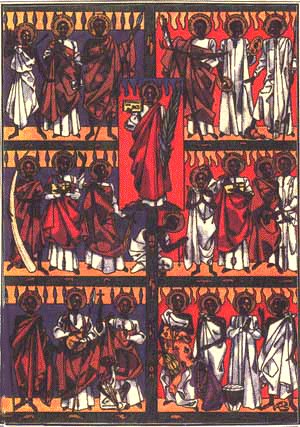Saint Charles Lwanga and Companions
Feast Day June 2

All martyrs’ stories are inspiring, but the martyrdom of young people really makes us think.
By 1879 the first Catholic missions were started in Uganda and other parts of Central Africa. Under King Mtesa missionaries preached, people studied the faith, and many believed in Jesus. Unfortunately King Mtesa was succeeded by King Mwanga, who began persecuting the Christians in Uganda.

Charles Lwanga was a young man, probably in his late teens, who was a page in the court of King Mwanga. After Mkasa, the Christian master of the court pages, criticized the king for his immoral acts and for murdering a group of missionaries, the king had him beheaded. On the same night Mkasa was martyred, Charles, a catechumen, was baptized. Charles replaced Mkasa as head of the pages and continued to encourage the young men to refuse to take part in the pagan customs of the country. Later a young page refused to become involved in the king’s immoral acts and confessed that a page named Denis was instructing him to be a Christian. This angered the king so much that he sent for Denis and thrust a spear through his throat. Then Mwanga summoned all the pages and separated the Christian pages from the rest. He commanded his soldiers to kill Charles Lwanga and his friends. Most of the pages were under the age of twenty-five. The youngest was thirteen years old.
In prison Charles inspired the others to be courageous and faithful. The boys were executed thirty-seven miles away. Three were killed on the road. Charles was burned alive. The others met the same fate or were beheaded. They prayed and sang enthusiastically at their deaths.
After their deaths, many other Christians were persecuted and killed. The example of these teenagers and men inspired other people, and in Africa the faith grew and spread. It has refused to die.
Twenty-two Ugandan martyrs, including Charles and the pages, were canonized.
from Saints Kit
Image credit: Saint Charles Lwanga and his 21 followers by Albert Wider, 1962. Public Domain via Wikimedia.

